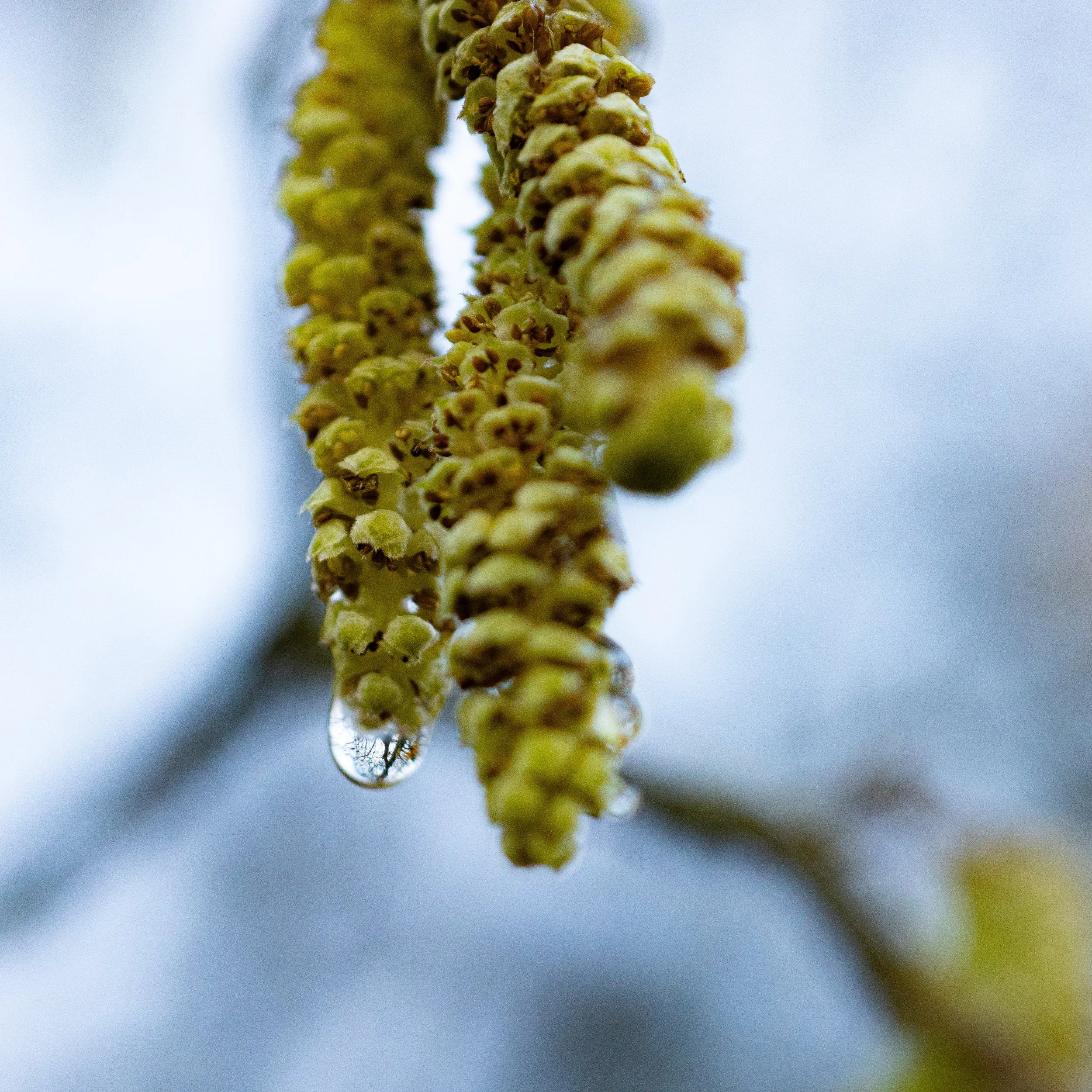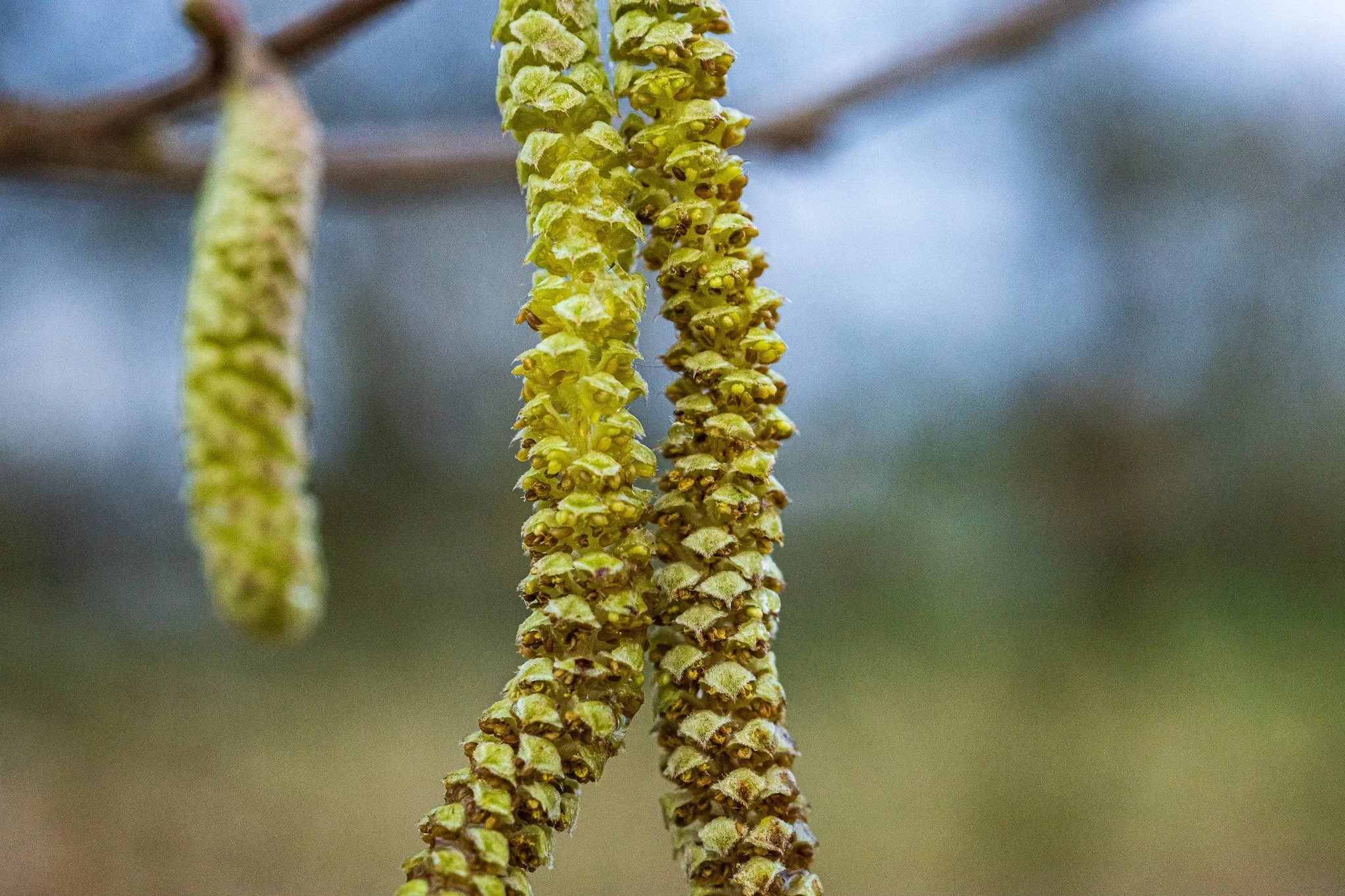How Do Hazelnut Trees Reproduce?
On my winter walks along the Willamette River, I find myself looking for interesting things on the trees and shrubs about. Right now, there is not much growing. The trees have lost their leaves, the air is brisk and wet, and mud abounds on my shoes and pants. The river is muddy too, and it rages along next to me while I walk on the asphalt bike path.
Leaving this path, I head into a forested area that grows near the river. In this forest, there are a few multi-stem shrubs, and on their branches are little yellow and white dangly things that shimmer in the light. I am immediately drawn to them as they appear to be the thing I’ve been waiting for, the most interesting thing outside during this dreary time.
Upon a closer look, I realize I’m seeing male flowers on a hazel shrub. It is hard to identify the shrub further than that in the winter, as the plant is without leaves, female flowers, and hazelnuts. Not only that, but the Willamette Valley is famous for the acres of hazelnut trees (Corylus avellana x Corylus maxima) that grow for commercial purposes.
Birds can carry hazelnuts from trees and deposit them in the wild, meaning that these hazel shrubs could be any of four possible species or a hybrid of them. I will have to return to this particular plant in the summer, when hazelnuts develop, and the tree will be easier to identify. For now, I know it is one of these four species or a hybrid of some of them:
Male hazelnut flowers have raindrops falling off them.
Corylus cornuta “Beaked Hazelnut”
Corylus cornutacalifornica “Western Beaked Hazel”
Corylus avellana “European Hazel or Filbert”
Corylus maxima “Large Filbert”
As you can see, there are many different shrubs and trees in the Corylus or hazel genus. The main native Corylus shrub in the Pacific Northwest is Corylus cornuta var. californica, commonly called the western beaked hazel. Although I hope the shrub I’ve found is this native, as Corylus cornuta var. californica is more resistant to eastern filbert blight and better for this ecosystem, the unidentified shrub is lovely and productive for this environment, regardless of its origin. Not only do all Corylus species produce nutritional hazelnuts for local wildlife, but these shrubs are also deciduous and deposit their leaves to feed the soil below each fall.
The main reason this plant spoke to me, and the reason it continues to amaze me, is for its showy blooms that develop each year. At a time when nothing else seems to be growing or alive, it is the hazels of all different species that drop their dangling flowers for a spectacular winter display. Catkins are one of the first symbols of the coming spring, and they herald in hope for the warmer times ahead.
Hazel trees, or filberts as they’re sometimes called, have male flowers that are phallic in their shape, and, being true to their shape, their purpose is sexual.
Catkins contain the male flowers of the hazel tree, and these tiny flowers contain pollen. Trees in the Corylus genus are monoecious, meaning they have separate male and female flowers on the same tree. The male flowers grow first, and then the inconspicuous female flowers sprout on buds further along the branch. The female flowers have little red stigmas that receive the pollen from the male catkins.
Female flowers that receive pollen then develop into hazelnuts with leafy husks. This annual sexual dance encourages cross-pollination, as the pollen from the male blooms can drift in the wind to receptive stigmas on other Corylus trees in the general vicinity.
The male flowers dump pollen that falls into the female flowers.
It also means that each year Corylus species are having sex far and wide with different sexual partners, no matter if they are native or not. This cross-pollination event encourages new cultivars of Corylus as the pollen from different species and varieties mix with each other’s ovules to form seeds with varied genetic material. Native varieties are more ecologically friendly and beneficial for wildlife, although on the other hand, the planet is changing rapidly with climate change-associated events, and it will require new plant species to fit into evolving ecological niches.
Knowing these things, I settle on the idea that plants that are adapted to the changing environments will thrive and fill the ecological niches that will exist in our future world. Yes, currently the species listed above are the Corylus species that grow on earth today, and they all have their unique benefits for their native environments. As the Earth changes, plants will have to adapt to new environments to survive and thrive in tomorrow’s world.
For now, I will enjoy the blooms for their unique beauty and form. Soon, I will look for the little red stigmas of the female Corylus flowers. In the spring and summer, I will observe this wonderful plant and get closer to discovering its true identification.


